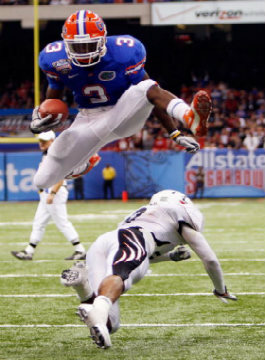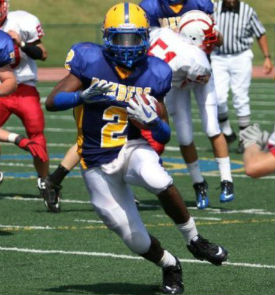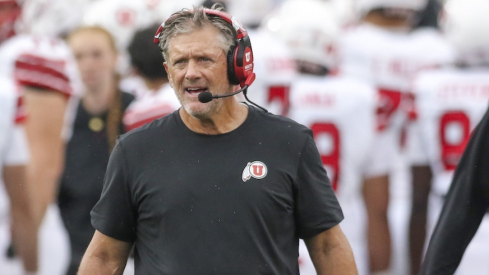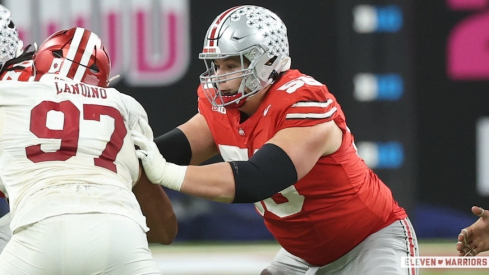 Pfff, Beanie could do this too.
Pfff, Beanie could do this too. This week's stat session is the first in a short series detailing different position groups from Urban's teams at Florida. The idea is to give a breakdown (light on math, actually) of how Urban's Florida teams differed from Ohio State at the position-level so we have a better idea of what to expect.
I wanted to start off this series with Urban's running backs because of the relatively high amount of debate surrounding how they will be used, how many carries they will get, and what they will physically look like.
For instance, the excellent Florida blog Bourbon Meyer wrote Buckeye Nation a "What You Should Know About Urban" piece and had this to say about tailbacks:
...be cautious about how excited you get about any running back that Urban recruits and signs. Urbs won a lot of games with Florida using the running back as a tool, but either never used the tailback as a feature in the offense or never recruited a 20+ carry per game guy.
There has been a lot of discussion (read: fear) amongst the 11W commentariat about whether this is true. Why not actually take a look and test these questions ourselves?
I took a sample of the running backs on Urban's Florida rosters between 2006-2010 that had at least ten carries in a season. I also included "pivot players," which are designated as either RB/WR or ATH on the official UF rosters.
Notably, this sample of running backs leaves off walk-ons and Tebow, who admittedly was a huge part of the running game. If you'd like to see the list, here it is.
Do Urban's Running backs receive as much as they run?
Many fans seem to think that most new running back recruits will end up being pivot backs - sometimes in the backfield, sometimes in the slot - more than running up the gut. It turns out that this definitely is not so - it's actually fairly rare for a running back to also be a consistent receiver.
My dataset is coded such that each running back-year is a separate data point, meaning that Percy Harvin receives an entry for each year he had more than ten carries. Of these 22 running back-years, only five times did a running back have over 200 receiving yards.
Furthermore, Percy Harvin is responsible for three of those instances (years with 427, 858, and 644 receiving yards), with Brandon James and Chris Rainey each with one year at over 200 yards each. In contrast, Brandon Saine had 225 and 195 receiving yards in his final two years here.
Are Urban's Running backs all small and quick?
Of the backs currently on the Ohio State roster or committed for 2012/13, there's a clear division between the small and quick guys - usually pivot players - and large power backs. It's easy enough to divide Jordan Hall, Warren Ball, and Ezekiel Elliot on one side, and Carlos Hyde, Rod Smith, and Bri'onte Dunn on the other.
Of Florida's players, four out of nine backs were pivot players between 2006 and 2010 (or an average of about two per year).
 Ezekiel Elliot, of the Jordan Hall-mode
Ezekiel Elliot, of the Jordan Hall-modeOnly three different players weighed over 200 pounds or were what we would traditionally think of as power backs, however - DeShawn Wynn, Kestahn Moore and Emmanuel Moody. Moody wasn't really a powerback either, but just a bigger running back, and the other two were holdovers from the Zooker days.
From the Bourbon Meyer article:
Florida just graduated his two best tailbacks: Jeff Demps and Chris Rainey. Combined, they likely weigh less than Jake Stoneburner. Don’t believe me? Florida’s two best “running backs” in Meyer’s tenure in Gainesville were a Quarterback (Tebow), and a Wide Receiver (Percy Harvin).
So, yeah - the majority of Urban's running backs at Florida were in fact under 200 pounds, even the non-pivot players.
However, I'm not entirely convinced this pattern will hold here at Ohio State - just look at how hard Urban recruited Bri'onte. It wasn't just so he could sit on the bench. Furthermore, he has offers out to Derrick Green, Corey Clement, Jonathan Hilliman and Jonathan Haden, all bigger guys.
The reason Meyer never recruited many >200 pound running backs is because he didn't need to - he already had a powerback by the name of Tim Tebow. It's not that Meyer's offenses never used bigger running backs, it's just that often the best one was also the quarterback.
However, Braxton simply is not the same type of runner at Tebow. Meyer's offense at Ohio State will need bigger guys like Hyde, Smith, and Dunn for plays like inside zone. The point is that Meyer wants different and versatile players in his offense. Having smaller and shiftier Braxton at the helm opens the door for bigger backs to get their carries.
Does urban not have any feature backs?
Besides wondering whether he'd have a place in Meyer's offense, Bri'onte was almost pulled to Michigan with the promise of becoming their feature back - the guy who averages close to 20 carries a game and 200 per year, and who breaks the 1000 yard mark rushing.
1000 yards on 200 carries equates to a nice average of 5 yards per carry. Florida's backs under Meyer, however, were regularly pushing 6.5 to 8 yards per carry, including Harvin's ridiculous career average at over 9 yards per carry. The secret? They did so on less carries, with more backs toting the rock each game.
Florida's backs under Meyer each average just about 6 carries per game, and only twice did a back have over a hundred carries in a season (DeShawn Wynn in '06 and Kestahn Moore in '07). Contrast this with Ohio State, where Beanie had ~67% of the carries in 2008, and where there has been a back with over 200 rush attempts in every year save for the '09 campaign.
This is to say that Urban does spread the ball around more, but each back typically has a significantly higher average yards per carry too.
In short, most of the stereotypes about Urban's running backs were at least somewhat true - they're typically a bit smaller, there are pivot players, and he spreads the ball out to more backs - but that isn't a bad thing, nor are these trends necessarily going to continue at Ohio State. It's difficult to stress how unique Tebow and Harvin in particular were and how much the offenses reflected their specialized abilities. Urban has consistently added wrinkles to his offense each year based upon his personnel, all under the same spread principles.

